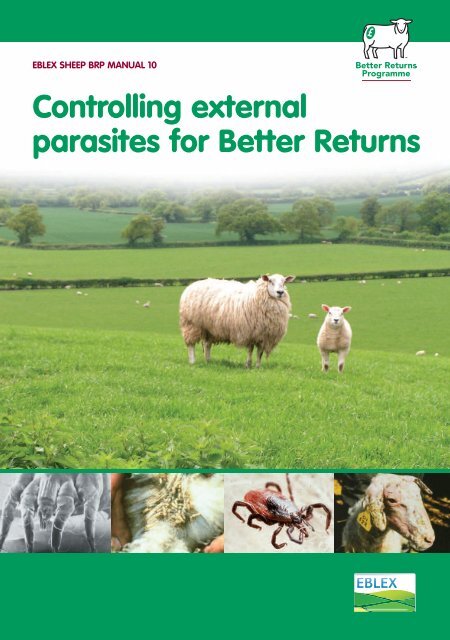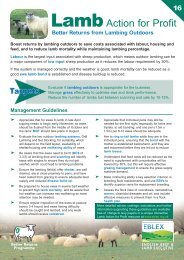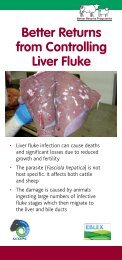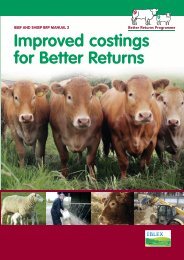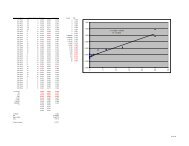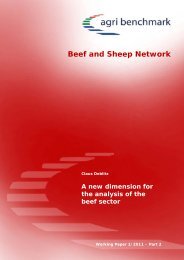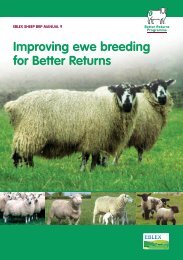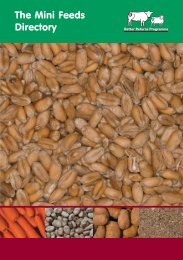Controlling External Parasites for Better Returns - Eblex
Controlling External Parasites for Better Returns - Eblex
Controlling External Parasites for Better Returns - Eblex
Create successful ePaper yourself
Turn your PDF publications into a flip-book with our unique Google optimized e-Paper software.
EBLEX SHEEP BRP MANUAL 10<br />
<strong>Controlling</strong> external<br />
parasites <strong>for</strong> <strong>Better</strong> <strong>Returns</strong>
The in<strong>for</strong>mation in this booklet was compiled by Chris Lloyd and<br />
Katie Brian, <strong>Better</strong> <strong>Returns</strong> Programme, from original material<br />
supplied by Dr Peter Bates.<br />
EBLEX <strong>Better</strong> <strong>Returns</strong> Programme is grateful to all those who have<br />
commented and contributed to this production.<br />
Illustrations: Tebbit Design<br />
Photography: Dr Peter Bates<br />
For more in<strong>for</strong>mation contact:<br />
<strong>Better</strong> <strong>Returns</strong> Programme<br />
EBLEX<br />
Stoneleigh Park<br />
Kenilworth<br />
Warwickshire<br />
CV8 2TL<br />
Tel: 0870 241 8829<br />
Fax: 0844 744 6253<br />
Email: brp@eblex.ahdb.org.uk<br />
www.eblex.org.uk<br />
© EBLEX 2012<br />
While the Agriculture and<br />
Horticulture Development Board,<br />
operating through its EBLEX division,<br />
seeksto ensure that the in<strong>for</strong>mation<br />
contained within this document is<br />
accurate at the time of printing, no<br />
warranty is given in respect thereof<br />
and, to the maximum extent<br />
permitted by law, the Agriculture and<br />
Horticulture Development Board<br />
accepts no liability <strong>for</strong> loss, damage<br />
or injury howsoever caused<br />
(including that caused by negligence)<br />
or suffered directly or indirectly in<br />
relation to in<strong>for</strong>mation and opinions<br />
contained in or omitted from this<br />
document.<br />
The text of this document (this<br />
excludes, where present, any logos)<br />
may be reproduced free of<br />
charge in any <strong>for</strong>mat or medium<br />
providing that it is reproduced<br />
accurately and not in a misleading<br />
context. The material must be<br />
acknowledged as Agriculture and<br />
Horticulture Development Board<br />
copyright and the document title<br />
specified. Where third party material<br />
has been identified, permission<br />
from the respective copyright holder<br />
must be sought. Any enquiries<br />
regarding this document should be<br />
sent to: EBLEX Division, AHDB,<br />
Stoneleigh Park, Kenilworth,<br />
Warwickshire CV8 2TL.
Contents<br />
2 Counting the cost<br />
3 Keep your guard up<br />
4 Sheep scab<br />
6 Blowfly (‘strike’)<br />
7 Lice<br />
8 Ticks<br />
9 Keds and headfly<br />
10 Treatment<br />
12 Non-parasitic skin diseases<br />
Parasite control will deliver <strong>Better</strong> <strong>Returns</strong><br />
1<br />
Many external parasites that infest UK<br />
sheep flocks can hardly be seen with the<br />
naked eye, yet their effects on animal<br />
health, welfare and, of course, profit –<br />
can be significant.<br />
This booklet aims to help you understand<br />
and identify the particular pests found<br />
amongst your flock. It provides<br />
in<strong>for</strong>mation on how infections can spread<br />
and how to implement effective control<br />
strategies.<br />
Through effectively prevention and<br />
control of external parasites, sheep<br />
farmers can improve the health of their<br />
flocks and deliver significant welfare<br />
benefits.<br />
What is clear is that by fighting off the<br />
menace of external parasites, sheep<br />
farmers can improve the health of<br />
their flocks and deliver significant<br />
welfare benefits.<br />
Katie Brian<br />
EBLEX Project Coordinator
Counting the cost<br />
<strong>External</strong> parasites are robbing the sheep industry of returns.<br />
For example<br />
£8.3* million lost to sheep scab<br />
£2.2 million lost to blowfly<br />
Permanent parasites<br />
Eg scab mites, complete their whole life cycle on<br />
the sheep.<br />
Spread has to be by contact with infected sheep.<br />
2<br />
Semi-permanent parasites<br />
Eg blowflies that cause strike, are typical of semipermanent<br />
external parasites.<br />
Part of the life cycle is completed away from the<br />
sheep. There<strong>for</strong>e, you need to know the alternative<br />
hosts and either tackle them, or keep sheep away<br />
from the risk eg dung heaps.<br />
A joined up approach bringing together an understanding of the parasite lifecycle, routes of infection<br />
and effective control has become increasingly important as pressure on the use of chemicals increases.<br />
Effective management is an important part of maintaining the limited weapons in the armoury<br />
available to sheep farmers.<br />
*Reference: Nieuwhof G.J., Bishop S.C., Costs of the major endemic diseases of sheep in Great Britain and the potential benefits<br />
of reduction in disease impact. Anim. Sci. 81 (2005) 23-29.<br />
Prevention is always better than cure
Keep your guard up<br />
<strong>External</strong> parasites pose a threat to sheep flocks the whole year round and vigilance is the key<br />
to fighting off the menace. Good practice involves three key steps:<br />
<strong>External</strong> parasites – a year round threat<br />
3<br />
Biosecurity<br />
Ectoparasites can often be brought in on stock. To ensure trouble is not<br />
imported onto the farm, treat sheep on arrival <strong>for</strong> sheep scab and<br />
internal parasites and keep new sheep separate from the main flock <strong>for</strong><br />
at least 21 days. Inspect them regularly <strong>for</strong> physical symptoms and loss<br />
of condition. If you suspect an ectoparasite consult your vet as soon<br />
as possible.<br />
Maintain field boundries and gates to protect stock.<br />
Inspection<br />
Regularly inspecting a flock will often alert you to the early signs of a<br />
parasite attack. Any animal seen rubbing, scratching or chewing its<br />
fleece needs to be caught and inspected.<br />
Handling<br />
<strong>Parasites</strong> often cause the fleece to loosen or body condition to be lost,<br />
so regular handling will again provide early warning of potential<br />
infestations.<br />
J F M A M J J A S O N D<br />
Sheep Scab H H H M M M M M M H H H<br />
Blowfly L L L M H H H H H M M L<br />
Lice H H H M M M M M M M M M<br />
Ticks L M M M M H H H M M L L<br />
Keds H H H M M M M M M H H H<br />
Headfly L L L L M H H H H M L L<br />
Risk:<br />
High Middle Low
Sheep scab (Permanent ectoparasite)<br />
Sheep scab is a progressive, debilitating mange<br />
caused by secretions from scab mites living at the<br />
edge of expanding, pus-covered skin lesions.<br />
Once a notifiable disease, control is now covered<br />
by the Sheep Scab Order (1997). Cases of scab<br />
have increased since the end of compulsory<br />
treatment.<br />
Susceptibility varies between individual animals<br />
and some breeds are more prone to infestation.<br />
Lifecycle<br />
In ideal conditions, the egg-larvae-nymph-adult<br />
lifecycle takes 14 days. Once fertilised an adult<br />
female does not mate again but lives <strong>for</strong> around<br />
40 days, laying one to two eggs daily. The adult<br />
female mite is just visible to the naked eye -<br />
pearly white and globular - about 1mm long.<br />
Infesting mites feed within hours of sheep contact.<br />
After feeding <strong>for</strong> a minute a tiny fluid-filled area<br />
appears on the skin surrounded by an inflamed zone.<br />
4<br />
These expand into larger pustules which<br />
eventually rupture and discharge liquid.<br />
The time from initial contact to displaying visible<br />
lesions can be from 60 to 240 days.<br />
Timing<br />
Sheep scab is mainly a winter problem, although<br />
summer cases are known.<br />
Signs<br />
Sheep are the only hosts, mite infestation is<br />
widespread and can be fatal if left untreated.<br />
Early symptoms are mild. Animals may rub against<br />
fence posts, toss their heads or be restless. Later,<br />
clean areas of fleece appear as sheep lick the lesion.<br />
Dirty areas may indicate where animals have<br />
scratched with hind feet. Badly affected animals<br />
may have a general air of depression.<br />
Mites usually colonise withers, flank and brisket.<br />
Slower growth is recorded on the face, head,<br />
tailhead and belly.<br />
Mites are usually found around the edges of the<br />
lesion as it spreads around the sheep.<br />
Diagnosis is important as lice can cause similar<br />
symptoms, requiring different treatment.
Sometimes, mites migrate to the centre of the lesion<br />
<strong>for</strong>ming a ‘flaky’ scab. Large numbers of mites will<br />
be found on, or under, flakes.<br />
Wool over infested areas can become loose and<br />
sheds easily. Sores can open and bleed from rubbing<br />
or scratching. Sheep rapidly lose condition.<br />
5<br />
Control<br />
Once identified, scab mites must be eradicated<br />
with an appropriate chemical treatment.<br />
Mites have developed full resistance to plunge dips<br />
containing synthetic pyrethroids. However there<br />
are no reports of resistance to organophosphorus<br />
products or Macrocyclic Lactone (MLs). If<br />
resistance has been reported an alternative<br />
product must be used.<br />
Scab mites can live off the host animal <strong>for</strong> up to<br />
17 days and still infest sheep. There<strong>for</strong>e, ensure all<br />
buildings, fences, gates and vehicles are disinfected.<br />
Once clear of mites, operate good bio-security to<br />
avoid re-infestation. Source all new stock from<br />
reputable sources, and quarantine all incoming<br />
stock <strong>for</strong> at least 21 days.<br />
Good fencing - ideally two parallel lines of fence<br />
one metre apart, will prevent contamination from<br />
untreated flocks on neighbouring farms.<br />
DON’T<br />
BUY IN<br />
SCAB!
Blowfly (‘strike’) (Semi-permanent ectoparasite)<br />
Blowfly strike is caused by larvae, or maggots,<br />
of greenbottle, bluebottle or black blowflies<br />
infecting animal tissues. Left unchecked, sheep<br />
die an agonizing death – thus strike poses a<br />
serious welfare challenge.<br />
Infestation develops where the eggs are laid.<br />
Breech or tail strike arises from eggs laid around<br />
the back end - the most common <strong>for</strong>m. In body<br />
strike, flies target the front of the animal. Foot<br />
strike and head strike are also possible.<br />
Lifecycle<br />
Pregnant female flies travel several kilometres in<br />
search of a host and can lay up to 3,000 eggs in<br />
ten batches over three weeks.<br />
Attracted by the smell of sweat or fleece<br />
contaminated with decaying organic matter, urine<br />
or faeces - the first wave leaves eggs on damaged<br />
or soiled areas. The eggs hatch within 10-12 hours<br />
and over three days larvae enter the skin using<br />
enzymes to digest the flesh.<br />
More flies are attracted by the primary lesion and<br />
secondary bacterial infection.<br />
Larvae leave the sheep to pupate in soil, where<br />
they can remain <strong>for</strong> 2-4 weeks in the summer.<br />
They overwinter as pupae remaining inactive until<br />
the soil temperature rises above 7°C.<br />
6<br />
Timing<br />
Body strike occurs in warm, humid weather<br />
conditions - from April to December in the<br />
South, and June to November in the North.<br />
Breech strike is less weather dependent with<br />
urine and dags (faeces) attracting flies.<br />
Signs<br />
The initial lesion is a foul smelling area of moist<br />
brown wool with maggots visible.<br />
Sheep are distressed and depressed. In breech<br />
strike, animals stamp their hind legs and shake<br />
their tails vigorously.<br />
Control<br />
Risk can be reduced by good husbandry. Examine<br />
flocks twice a day during the fly season.<br />
Shearing reduces susceptibility to breech and body<br />
strike. Crutching, or dagging, from early April helps<br />
reduce risk.<br />
Tail docking, (not less than 4”) reduces breech<br />
strike. <strong>Controlling</strong> intestinal parasites, and<br />
reducing digestive upsets from changes in diet<br />
also helps.<br />
Cull rams and ewes that are affected several times<br />
in a season.<br />
Dispose of carcases quickly and treat footrot<br />
immediately. Both will attract blowflies.<br />
Treat any animal suspected of being struck<br />
immediately with a suitable plunge dip, spot-on<br />
or pour-on treatment. Be sure to observe<br />
withdrawal periods.
Lice (Permanent ectoparasite)<br />
Lice infestations are occurring more widely<br />
across the UK following the de-regulation of<br />
scab control. Confusion with scab often leads<br />
to lice persisting. They particularly affect<br />
long-fleeced sheep and those in poor health.<br />
Lifecycle<br />
Lice infestations mostly occur in winter and<br />
spread slowly through sheep flocks. Prevalence is<br />
weather dependent.<br />
Eggs hatch after one to two weeks, and lice then<br />
go through a series of nymphal stages <strong>for</strong> one to<br />
three weeks. Lice feed on wool and skin debris but<br />
can survive off the host <strong>for</strong> up to 17 days. Adults<br />
live up to a month.<br />
Timing<br />
Mainly winter, although infested sheep have been<br />
recorded in the summer.<br />
7<br />
Signs<br />
Lice are small, pale to red/brown, with broad head<br />
and chewing mouthparts.<br />
Lice are found amongst wool. Sheep nibbling their<br />
fleece, or rubbing, are typical signs of the<br />
irritation of lice infestation. Sheep can carry<br />
significant numbers without obvious clinical signs.<br />
The clinical signs, eg itching and wool loss, can<br />
be confused with sheep scab but lice can also<br />
occur alongside scab infestation.<br />
Control<br />
Good bio-security measures should aim to<br />
prevent contact with infested<br />
sheep, eg closed flocks,<br />
thoroughly cleaning transport<br />
vehicles, quarantine of all<br />
incoming stock and good<br />
fencing between<br />
neighbouring units.<br />
Populations decrease<br />
naturally with the onset of<br />
summer. Shearing can reduce residual populations<br />
by up to two thirds.<br />
If one animal is found to be infested, treat the<br />
whole flock with an ectoparasiticide, ideally just<br />
after shearing.<br />
Treatments include spot-ons containing<br />
deltamethrin, or cypermethrin and<br />
alphacypermethrin pour-ons. Lice can also be<br />
controlled by plunge dipping with diazinon.
Ticks (Semi-permanent ectoparasite)<br />
Ticks can carry several important diseases<br />
which affect sheep, other livestock and humans.<br />
Ticks can carry:<br />
tick-borne fever<br />
lamb pyaemia (‘cripples’)<br />
louping ill<br />
lyme disease.<br />
Tick populations are increasing. In some upland<br />
areas flock owners report 20% lamb losses from<br />
tick-borne diseases.<br />
Lifecycle<br />
Ticks pass through four stages egg, larvae, nymph<br />
and adult. All stages are parasitic, but they do<br />
spend long periods off the host living at the base<br />
of dense vegetation. Changes in farming practices<br />
such as reduced bracken control has increased<br />
tick numbers in upland areas considerably.<br />
8<br />
Eggs are laid in batches of several thousand and<br />
all active stages feed on blood. Each stage feeds<br />
only once.<br />
Adult ticks only feed on larger mammals, such<br />
as sheep. Larvae and nymphs can also feed on<br />
young lambs, other small mammals and birds.<br />
Ticks actively seek a host using a sensory<br />
organ on the front legs that detects minute<br />
concentrations of carbon dioxide and heat from<br />
animals walking by. The tick attaches itself to the<br />
host by waving its legs in the air.<br />
After feeding the tick drops off the host in to<br />
vegetation to digest the blood meal and moult to<br />
the next stage.<br />
Timing<br />
There are generally two waves of tick activity.<br />
Adult ticks and nymphs feed between February<br />
and October with nymph numbers rising<br />
markedly in humid conditions from July onwards.<br />
Signs<br />
Ticks attach to face, ears, inside top of leg and<br />
groin. Some species cause intense irritation and<br />
symptoms can be confused with scab or lice.<br />
Control<br />
Sheep must be protected against ticks. Effective<br />
plunge dipping, spot-on and pour-on chemical<br />
treatments are available.
Keds are wingless, blood-feeding<br />
flies. Adults are red/brown, 4–6mm<br />
long, with a broad head and stout<br />
piercing mouthparts.<br />
Keds spend their entire life on sheep and in large<br />
numbers cause varying degrees of anaemia. Excreta<br />
can stain wool leading to downgraded fleeces.<br />
Signs<br />
Sheep infested with large numbers will be restless<br />
and bite, kick and rub affected areas. Keds can be<br />
distinguished from ticks as they have six legs<br />
(ticks have eight).<br />
Control<br />
Dipping largely eliminated keds so infections are rare.<br />
Sheep indentified with keds should be isolated,<br />
inspected and treated. Deltamethrin pour is licenced<br />
to control keds.<br />
9<br />
Keds (Permanent ectoparasite) Head fly (Semi-permanent ectoparasite)<br />
Similar in size to House Fly, with an<br />
olive-green abdomen and orangeyellow<br />
wing bases.<br />
While head fly occurs throughout<br />
Britain, damage from this pest has only been recorded<br />
in northern England and Scottish Borders.<br />
Horned sheep with hairy faces, eg Blackface and<br />
Swaledale, are most susceptible.<br />
Lifecycle<br />
Keds can complete their life cycle in just five weeks. Lifecycle<br />
Females live <strong>for</strong> four to five months, during this time The fly produces one generation a year. Eggs are laid in<br />
up to 15 larvae will be produced. The female retains late July and September in soil under dense vegetation,<br />
larvae within her body <strong>for</strong> seven or eight days until usually on the edge of coniferous woodland.<br />
fully-grown, then deposits it as an immobile pre-pupa<br />
Eggs hatch within seven days. Then carnivorous larvae<br />
that pupates once attached to the wool.<br />
feed and grow until late autumn. Development stops<br />
Pupae develop over a narrow temperature range of in winter. Pupation occurs in May, with adults<br />
25°-34°C, with optimal development at 30°C. Puparia emerging four weeks later.<br />
are glued to the fleece and carried away from the skin<br />
as the fleece grows. The temperature near the skin Timing<br />
will be 37°C - cooler towards the fleece tip. Puparia<br />
Head flies are only active during summer days. They<br />
are deposited where a suitable temperature will be<br />
will not fly in windy conditions.<br />
found during the three weeks of pupal development.<br />
Pupa can be found in the neck, <strong>for</strong>elegs and flanks of Signs<br />
adult sheep. In lambs, they tend to concentrate on<br />
Head flies feed at the base of horns and on secretions<br />
hind legs, neck and belly.<br />
from eyes and nose. Lesions at the skin/horn junction<br />
of young sheep and wounds, resulting from fighting<br />
Timing<br />
in rams, also attract head flies.<br />
Winter.<br />
Fly swarms cause head shaking, rubbing against the<br />
ground, or scratching with their hind feet. This may lead<br />
to broken, bleeding skin which attracts more flies.<br />
With continual feeding around lesions large areas of<br />
skin from the head can be lost. Affected sheep are<br />
susceptible to blowfly strike.<br />
Control<br />
Prevention using cypermethrin pour ons may need<br />
repeating every three weeks in high risk periods. Treat<br />
severely affected sheep with antibiotics and<br />
insecticidal cream. Wounds usually heal once fly<br />
activity ceases.
Prevention and treatment<br />
Which product?<br />
A range of treatment options are available:<br />
Injections<br />
quick and easy<br />
match dose to<br />
heaviest sheep<br />
in batch<br />
no risk of<br />
product loss<br />
requires sheep to be penned<br />
injection must be accurate.<br />
Pour-ons<br />
simple to use<br />
timing is<br />
critical<br />
may require<br />
more than one<br />
treatment<br />
avoid using within three months of<br />
shearing or slaughter<br />
use the correct gun with recommended<br />
nozzle.<br />
10<br />
Ectoparasites adversely affect animal welfare and,<br />
left untreated, may be fatal. Flock-owners have a<br />
legal responsibility to prevent or cure infestations.<br />
Failure to do so can lead to prosecution <strong>for</strong> animal<br />
cruelty.<br />
However, controlling ectoparasites can be difficult,<br />
especially as fewer and fewer treatments are<br />
available. For instance, 2006 saw synthetic<br />
pyrethroid sheep dips withdrawn.<br />
Ectoparasites affect productivity by:<br />
reducing ewes’ reproductive potential<br />
reducing meat and milk output<br />
increasing veterinary costs<br />
downgrading the wool clip.<br />
Plunge dipping<br />
ensure good coverage<br />
dip early in the day to<br />
allow sheep time to dry<br />
avoid hot or cold weather<br />
and heavy rain<br />
stressful, especially <strong>for</strong><br />
pregnant ewes<br />
avoid using within three months of shearing<br />
or slaughter<br />
drainage and disposal can be difficult<br />
farmers require a certificate of competence.<br />
Shower dipping<br />
cannot use plunge<br />
dip solutions<br />
ensure ‘dipping’ time<br />
allows product to<br />
reach skin<br />
not approved <strong>for</strong> scab control<br />
less effective fly control compared to plunge dipping.
Shower dips have been used <strong>for</strong> many years<br />
in Australia and New Zealand to control<br />
blowfly and lice. However in<strong>for</strong>mation on<br />
sheep scab control is limited.<br />
Always use treatments strictly according to<br />
manufacturers’ instructions.<br />
11<br />
Labour and equipment<br />
Some treatments require extra labour, fixed<br />
equipment and waste disposal. Calculate the<br />
requirements <strong>for</strong> your system and work<strong>for</strong>ce<br />
be<strong>for</strong>e deciding on a treatment method.<br />
After treatment<br />
Avoid handling sheep post treatment. Foot trim<br />
be<strong>for</strong>e treatment, or leave as long as practically<br />
possible after treatment.<br />
Caring <strong>for</strong> the environment<br />
Facilities should be available <strong>for</strong> the safe disposal<br />
of unused concentrate and unused dip wash.<br />
Dipping set-ups should be inspected regularly<br />
<strong>for</strong> cracks and leaks and should never be sited<br />
next to a water course. Kept treated sheep away<br />
from water courses <strong>for</strong> 14 days.<br />
Table showing the efficacy of currently available Ectoparasiticides in the UK<br />
Active Ingredient Administration Chemical Meat Withdrawal Scab Lice Ticks Strike<br />
Group (Days)<br />
Diazinon 60% Plunge Dip OP 70 C/P C/P C/P C/P<br />
Diazinon 62% Plunge Dip OP 70 C/P C/P C/P C/P<br />
Dicyclanil 5% Pour-on IGR 40 - - - P<br />
Dicyclanil 1.25% Pour-on IGR 7 - - - P<br />
Cypermethrin 1.25% Pour-on SP 8 - C/P C/P C/P<br />
Alphacypermethrin 12.5% Pour-on SP 49 - C/P C/P C/P<br />
Deltamethrin 1% Spot-On SP 35 - C C C<br />
Cyromazine 6% Pour-on IGR 28 - - - P<br />
Moxidectin 1% Injection ML 70 C/P - - -<br />
Moxidectin 2% Injection ML 104 C/P - - -<br />
Doramectin 1% Injection ML 63 C - - -<br />
Ivermectin 1% Injection ML 37 C - - -<br />
www.noahcompendium.co.uk 20th April 2012<br />
OP = organophosphate, IGR = Insect Growth Regulator, SP = Synthetic Pyrethroid,<br />
ML = Macrocyclic Lactone, C = Curative, P = Protective
Non-parasitic skin diseases<br />
Sheep can be affected by several non-parasitic skin diseases:<br />
Non-parasitic skin diseases of sheep<br />
Hereditary/ Red foot<br />
congenital<br />
Prion Scrapie<br />
Viral Border disease<br />
Orf (contagious<br />
pustular dermatitis)<br />
Foot and mouth disease<br />
Bacterial Actinobacillosis<br />
Clostridial infection of wounds<br />
Staphylococcal folliculitis<br />
Staphylococcal dermatitis<br />
Scald<br />
Fungal Ringworm<br />
Mycotic dermatitis<br />
Allergic Fly bite dermatitis<br />
reactions<br />
Non parasitic Forage mites<br />
organisms Soil nematodes<br />
Miscellaneous Photosensitisation<br />
Fleece rot<br />
Wool slip<br />
Skin tumours<br />
Sunburn<br />
Beware: orf, staphylococcal dermatitis, mycotic dermatitis, fly bite dermatitis and <strong>for</strong>age mite<br />
infestations can easily be confused with sheep scab.<br />
Correct diagnosis is essential - always consult your vet <strong>for</strong> a definitive diagnosis<br />
12
Best practice across the farm<br />
Do not import parasites.<br />
Check health status of<br />
your suppliers and<br />
quarantine all stock <strong>for</strong><br />
at least 21 days.<br />
Disinfect vehicles after use.<br />
Ticks are a threat in<br />
dense vegetation.<br />
Remove soiled wool.<br />
13<br />
Personal hygiene is important to<br />
prevent pests spreading to other<br />
stock or people.<br />
Have treatment facilities.<br />
Keep dips away from<br />
drains and watercourses.<br />
Treat footrot to avoid fly<br />
strike.<br />
Monitor flock regularly,<br />
watching <strong>for</strong> loose wool,<br />
rubbing, scratching and<br />
chewing.<br />
Examine twice a day in<br />
‘strike’ season.<br />
Scab and lice can<br />
survive up to 17 days<br />
on fences, gates, etc.<br />
Avoid contamination of<br />
water after treatment.<br />
Building structures can<br />
harbour pests and disease.<br />
Disinfect after each batch<br />
of stock.<br />
Beware of scab and lice in<br />
winter months.<br />
Woods and hedges harbour<br />
flies. Check any nearby<br />
stock regularly.<br />
Separation from<br />
neighbouring flocks<br />
to avoids spreading.
Other BRP publications available<br />
Beef BRP<br />
Manual 1 – Choosing Bulls to Breed <strong>for</strong> <strong>Better</strong> <strong>Returns</strong><br />
Manual 2 – Marketing Prime Beef Cattle <strong>for</strong> <strong>Better</strong> <strong>Returns</strong> (Updated 2012)<br />
Manual 3 – Improving Cattle Handling <strong>for</strong> <strong>Better</strong> <strong>Returns</strong><br />
Manual 4 – Beef Production from the Dairy Herd<br />
Manual 5 – Feeding Suckler Cows and Calves <strong>for</strong> <strong>Better</strong> <strong>Returns</strong><br />
Manual 6 – Improve Beef Housing <strong>for</strong> <strong>Better</strong> <strong>Returns</strong><br />
Manual 7 – Feeding Growing and Finishing Cattle <strong>for</strong> <strong>Better</strong> <strong>Returns</strong><br />
Manual 8 – Optimising Suckler Herd Fertility <strong>for</strong> <strong>Better</strong> <strong>Returns</strong><br />
Manual 9 – <strong>Controlling</strong> Worms and Liver Fluke in Cattle <strong>for</strong> <strong>Better</strong> <strong>Returns</strong><br />
Sheep BRP<br />
Manual 1 – Marketing Prime Lamb <strong>for</strong> <strong>Better</strong> <strong>Returns</strong> (Updated 2012)<br />
Manual 2 – Target Ram Selection <strong>for</strong> <strong>Better</strong> <strong>Returns</strong><br />
Manual 3 – Target Lamb Management <strong>for</strong> <strong>Better</strong> <strong>Returns</strong><br />
Manual 4 – Target Ewe Management <strong>for</strong> <strong>Better</strong> <strong>Returns</strong><br />
Manual 5 – Target Store Lambs <strong>for</strong> <strong>Better</strong> <strong>Returns</strong><br />
Manual 6 – Target Easier Management <strong>for</strong> <strong>Better</strong> <strong>Returns</strong><br />
Manual 7 – Target Lameness <strong>for</strong> <strong>Better</strong> <strong>Returns</strong><br />
Manual 8 – Target Worm Control <strong>for</strong> <strong>Better</strong> <strong>Returns</strong><br />
Manual 9 – Improving Ewe Breeding <strong>for</strong> <strong>Better</strong> <strong>Returns</strong><br />
Manual 10 – <strong>Controlling</strong> <strong>External</strong> <strong>Parasites</strong> <strong>for</strong> <strong>Better</strong> <strong>Returns</strong><br />
Manual 11 – Target Ewe Fertility <strong>for</strong> <strong>Better</strong> <strong>Returns</strong><br />
Manual 12 – Improving Ewe Nutrition <strong>for</strong> <strong>Better</strong> <strong>Returns</strong><br />
Manual 13 – Improving Sheep Handling <strong>for</strong> <strong>Better</strong> <strong>Returns</strong><br />
Joint Beef and Sheep BRP<br />
Manual 1 – Improving Pasture <strong>for</strong> <strong>Better</strong> <strong>Returns</strong><br />
Manual 2 – Improved Costings <strong>for</strong> <strong>Better</strong> <strong>Returns</strong><br />
Manual 3 – Improving Soils <strong>for</strong> <strong>Better</strong> <strong>Returns</strong><br />
Manual 4 – Managing Clover <strong>for</strong> <strong>Better</strong> <strong>Returns</strong><br />
Manual 5 – Making Grass Silage <strong>for</strong> <strong>Better</strong> <strong>Returns</strong><br />
Manual 6 – Using Brassicas <strong>for</strong> <strong>Better</strong> <strong>Returns</strong><br />
For more in<strong>for</strong>mation contact:<br />
<strong>Better</strong> <strong>Returns</strong> Programme<br />
EBLEX<br />
Stoneleigh Park<br />
Kenilworth<br />
Warwickshire<br />
CV8 2TL<br />
Tel: 0870 241 8829<br />
Fax: 0844 774 6253<br />
Email: brp@eblex.ahdb.org.uk<br />
www.eblex.org.uk<br />
© EBLEX 2012<br />
The tables and contents of this publication may not be<br />
reproduced without the express permission of EBLEX.<br />
Delivered by


